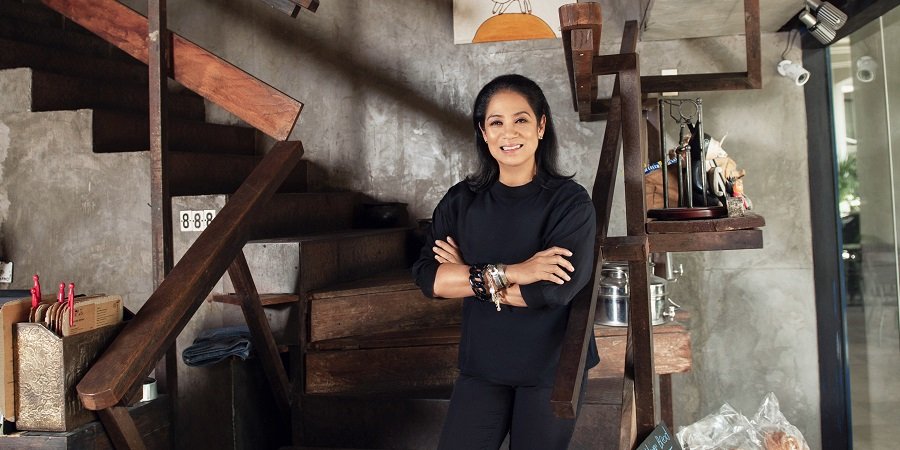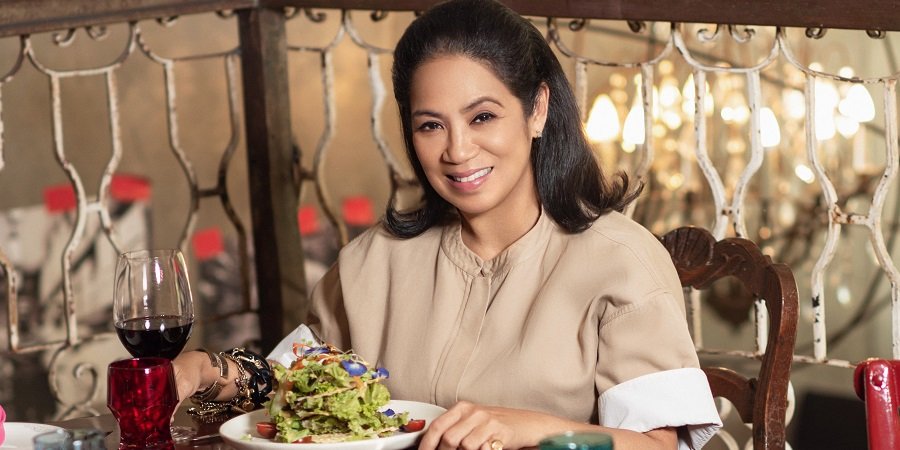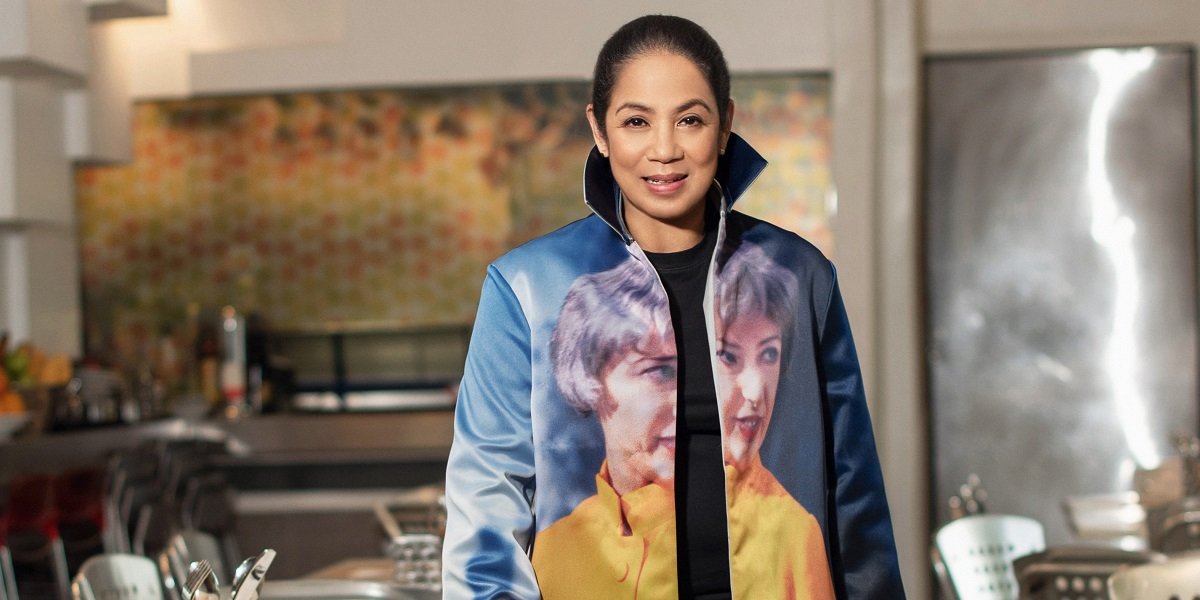It’s half pass the hour of nine on a Saturday morning and my system is in dire need of a jolt from caffeine. Rushing out from the comfortable cradle of a van ride to submerge myself aimlessly in a day’s worth of pleasing hysteria – I am ecstatic! Thoroughly primed but still somehow disheveled, I gather my wits and regain my composure. It’s unusually more difficult to do so today; I was, after all, meeting Asia’s Best Female Chef for 2016, Margarita Forés.
Margarita “Gaita” Forés is the culinary goddess and entrepreneur behind the success of Cibo di M and Fiori di M – considered as Manila’s gold standard in customized catering and banquet designs, and celebrated restaurants Cibo, Lusso and Grace Park. Born in prominence, being a scion of a highly influential family in the Philippines, Margarita Forés was always bound for a track to opulence. She is a celebrity by right, that much is certain, but what’s baffling is her voluntary immersion to refined simplicity as opposed to everything that vulgarly howls moneyed.
As a child, Margarita was primarily accustomed to the hustle and bustle of the city life in Manila but merrily vacations in her family’s home province. She traces back her most early and salient food memories to those summers she spent in her family’s estate in Negros – a region in Western Visayas, Philippines. She recalls, “I used to spend summers in the environment of a sugar mill. Learning how to cook my first pot of rice in a palayok [traditional red clay pot] – my nanny was the one who taught me under our house in Bacolod, the smell of bagasse, which was not very pleasant. If you live in a sugar plantation and a sugar mill, that aroma is what you sleep with every night and what you wake up to every morning. The memory of chomping off a piece of sugarcane with all that beautiful sweet juice, those are really vivid memories for me”. Even when in the city, the delicacies of her home province trails her as she remembers having family gatherings and life celebrations with Negros’ finest dishes lining up the table.
In 1971, her family, being in the opposite side of the political fence in the Philippines at that time, decided to uproot their lives they’ve built in Manila and move to New York. Margarita was unaware of it, but this chapter of her fascinating journey was pivotal to her love affair with food and the Italian culture. An Italian awakening, if you would. New York was fast becoming the center of globalization and she was positioned right in the middle of it, ready for life to hit her. For Margarita, New York was the ultimate melting pot. “If you want to know exactly what’s going on in the world, in the food industry, and you can only visit one place. It would be in New York” she muses. Young Italian immigrants are flocking to take a bite of the big apple and they came by the masses. Their culture, and more importantly, their food, spoke a language to Margarita she ardently embraced. Restaurants sprouted the sprawling streets of New York, each offering their take on the quintessential taste of Italy. Foreign, as it may seem back then, Italian cuisine caused an amiable ruckus amongst the society of hearty guzzlers.

Margarita Forés, a prominent figure in her trade, in an odd pleasantry, got her initial footing in the fashion industry and not in food. She was well in her prime years of 20’s when she got to work at a fur licensee of world-renowned Italian brand, Valentino. “The office was not on the glamorous part of the fashion district. It was in the fur market on 9th Avenue. It was a bit of a rough area but I loved it!” with the slightest hint of longing in her voice. Imagine her petite frame resolutely standing amongst the 5 feet 10’s and 5 feet 11’s of Manhattan, fitting coats and doing your run-of-the-mill secretarial work. “It was a very nice experience for a young girl and I think it kind of taught me how to be a survivor and a fighter because the environment was a little bit rough,” she continues. As fate would have it, Margarita got acquainted with the licensee director of Valentino who plucked her out of the jagged crowd in the fur market and chauffeured her to the ritzy 68th and Madison, the iconic Valentino HQ on the Upper East Side. “I moved to the Valentino office and I think that was the best decision because working with such an iconic Italian brand at a young age taught me what it takes to keep a brand strong and what it takes to sustain it, to build it” she validates. The work was a semblance to what she did at the fur licensee but being in that environment, the ambiance of it all, the copious amounts of glamour married to the rich Italian culture imbedded a thirst within young Margarita to delve further.
Further took her to the heartland of it all, the main source – Italia. The year was 1985. J. Amado Araneta, the patriarch of the illustrious clan, Margarita’s grandfather, had passed. This prompted their family to finally trace their way back to Manila. Not long after, the political phenomenon that lead to her family’s deracination has come to an inexorable halt. At that moment she was certain, she was once again home. But she had developed a tongue for the unfamiliar. She craved to tap into her sense of adventure. It was irrefutable; New York was nothing like Manila just as much as Manila was nothing like New York. “The pace of Manila was a little slow for me so I decided to find out if there was a place in Italy where I could learn about Italian cuisine and really learn it from the source.” Margarita had a Florence based friend who recommended an Italian lady that taught Italian cuisine courses, with a home kitchen as a makeshift educational institution. “Italian cuisine is really all about home cookery. I think that that’s the heart and soul of the cuisine. So to learn it from Italian old ladies is the best way to learn” she shares. It was an aggregated surrender to the experience, with undertakings that ranged from frequenting the markets in search of ingredients, renting cars on weekends to drive out to see the best of Italy, enjoying the company of locals and drinking their way of life. Margarita was adamant to her learning that she studied the language, familiarized herself with the produce, unwittingly cooked to her heart’s content and came out on top of her game. And then it was time for her to return home once more. Armed with the expertise she procured in her stay in Italy, she saddled up for an industry takeover.
Another early break caught the winds in Margarita’s sails. Few months after her return to Manila, she was offered by Hyatt Regency to organize a food festival at the most celebrated Italian restaurant in the country at that time, Hugo’s. It was the first of its kind and it took Manila by storm. The local media was all over the event like clockwork and it created such a buzz that it called for an encore. In the months sandwiched between the 2-part Italian food festivals that she did, Margarita has been going back and forth to Italy to hunt for the right quality of ingredients. The young chef started to see the culinary path as clear as day. She began orchestrating delectable small dinners for a clientele mostly consisting of her mother’s peers and recommendations through friends. The small dinner gatherings turned to massive scaled banquets. Her catering venture was and continues to be a success. Her passion for food and cooking panned out and just like that, it was a decade later. 1997 marked the year Margarita Forés became an eminent name in the world of restaurateur. Cibo brought about a modern-Italian approach to food and experience, a rarity in the Philippines at that time, but was nonetheless appreciated by its audience. The success of Cibo paved way for other food concepts Margarita birthed, all of which found their equal share of the metro scene limelight.

I slowly but steadily made my way up the wooden steps of the staircase at Grace Park. It was a quiet morning in Makati and I blatantly attempted to match the calm, afraid I might interrupt the shoot that was now taking place at the 2nd floor of this loft type restaurant. The lights were blinding, the camera flashed, but what’s more radiant was the beaming chef in her mocha toned sartorial finesse. In between takes, we got introduced from afar. She smiled and mouthed off a “hi” with a wave, followed by a “nice to meet you”. The shoot continued and I was offered my overdue cup of cognizance. I surveyed my surroundings and was washed with utmost approbation. I enjoyed the rustic-industrial look of the place. The way the wood, the metal, the bricks and gold details came together was a very welcome sight. Most the materials used to conjure the allure of an urban barn are repurposed from Margarita’s family plantation. Bricks that lined the walls at the ground floor are beautifully worn-out and jazzed up in haphazardly positioned flecks of gold paint. The chairs are mismatched, the cutleries are too, and that actually was the charm of it.
Farm to table, the concept behind Grace Park. It predominantly offers the best of Filipino cuisine with the best of the world. With the respect for ingredients that she’s acquired whilst in Italy, Margarita took it upon herself to travel the provinces of the Philippines and find out the good sources of produce and what was vastly available for sustainability. She worked closely with organic farmers and chose to showcase their products in the most palatable way she knew how. The name Grace Park was derived from a community in Caloocan, Philippines where Margarita’s father side of the family was from. “We would go there every Sunday and the family was not only a family of eaters but of dancers as well. Those memories of the food at home and at the same time, the Filipino farmers, that’s what I wanted to celebrate at Grace Park” she shares. She continues on saying “The word ‘grace’ took on a new meaning. It’s more about giving back and helping the people that bring food to the table; and knowing them and understanding their challenges, and understanding what we need to do as well to be able to help them”.
A quick pack up and we were on to our next location, Lusso. Now if Grace Park gave the feel of cozy and relaxed, Lusso is its night and day opposite. The entire dwelling is the epitome of luxury and class, truly old-world. Inspired by her travels and memoirs filled with lavish meals at the swankiest hotel lobbies around the world, the grandeur of silver plate service, Margarita felt that Manila was craving for this experience. Lusso, with its white-gloved servers, walls dripping in gold and mirrors, a grand chandelier that took over the entire ceiling and a parade of sterling silver cutleries is the exact breath of refinement the city desired. The limited seating makes the place feel more exclusive and therefore covetable. The cavalcade of epicurean offerings is the perfect representation of just how exquisite European dishes are and the taste was also a great part of the lure.
Last few shots taken with Margarita Forés in a structured, pearl-white garb, reminiscent of a chef jacket, and it was a wrap. It’s effortless, her display of sophistication. Need less to flaunt yet very much evident. Her name and accomplishments intimidate but her kind smile and the stories she carries are always inviting. Her desire to bring about a conversation in every experience she elicits through food upholds her position as one of the most influential driving forces in the industry today.
Photographer: VINCENT GOTTI

